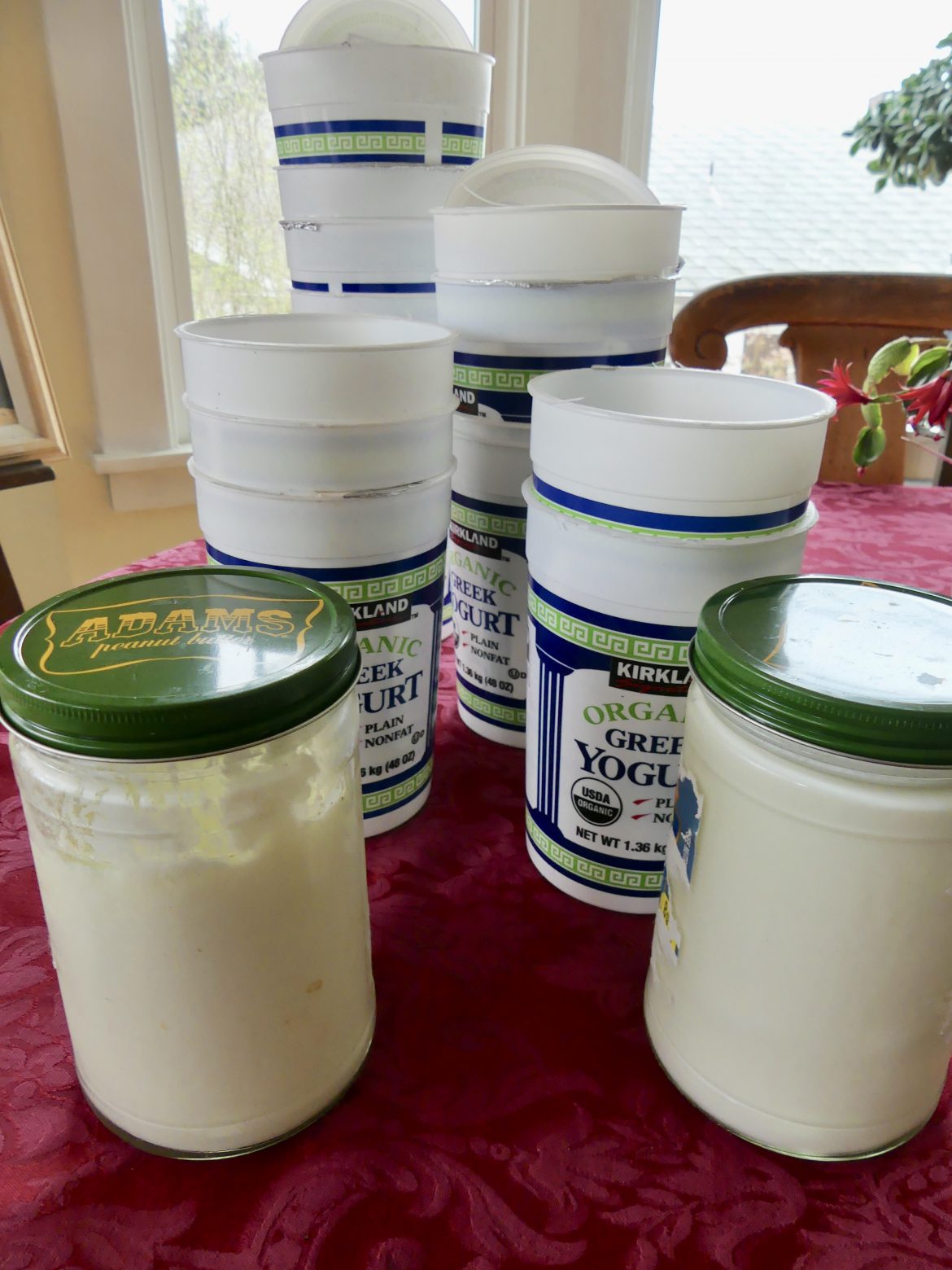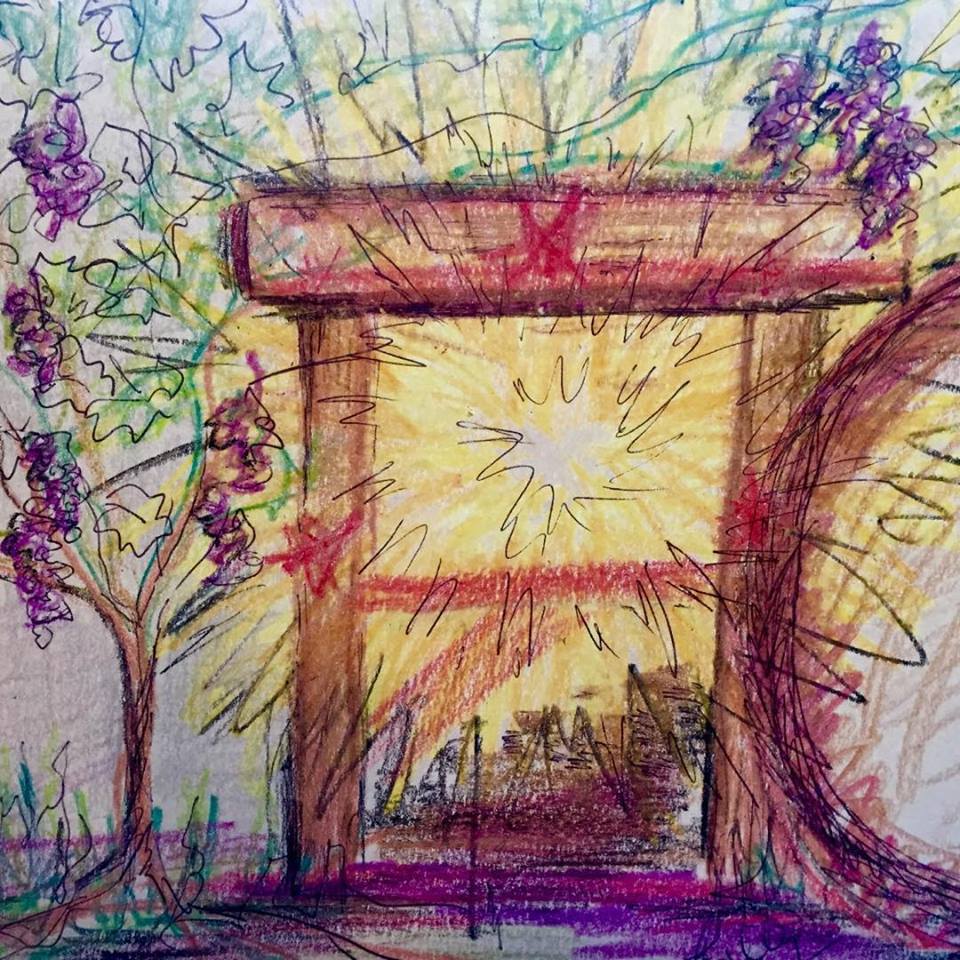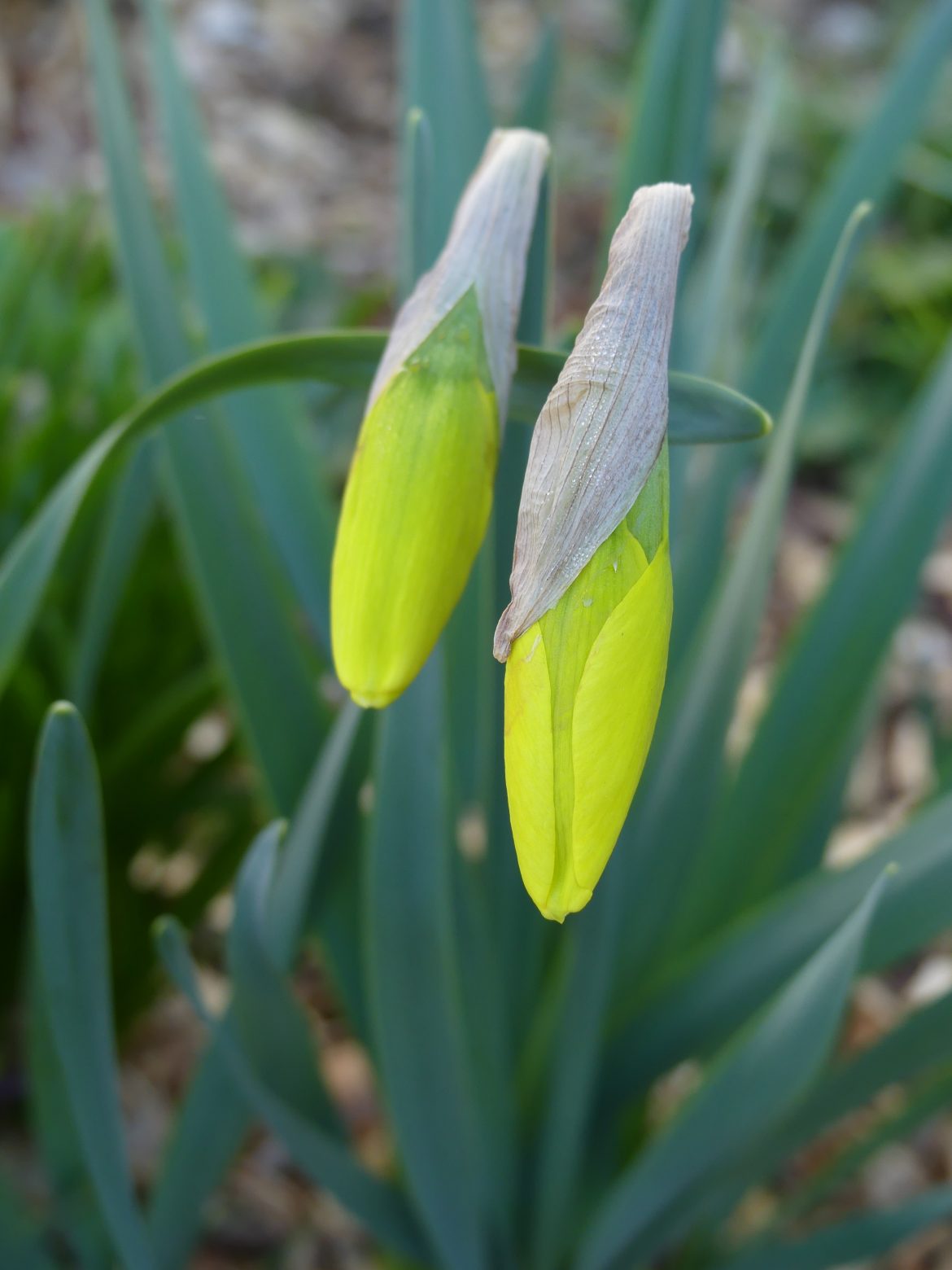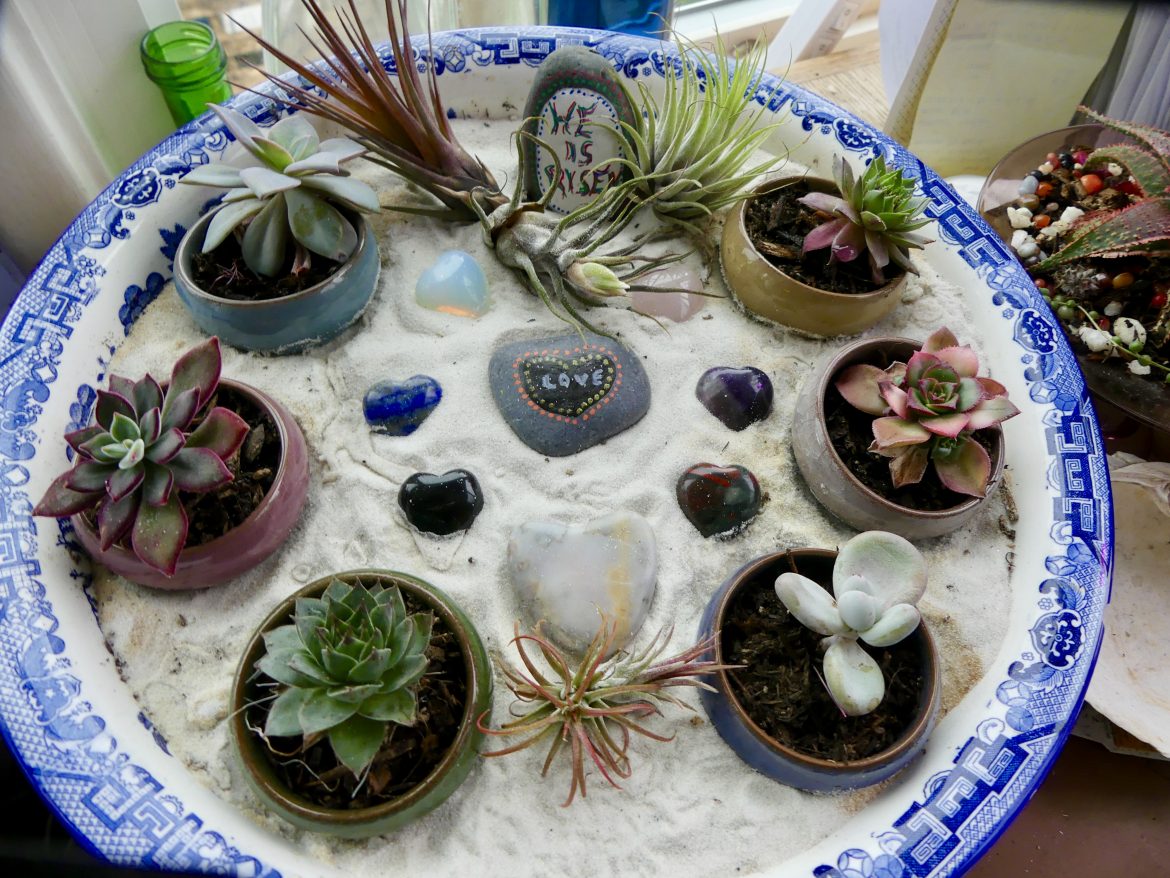by Mary Harwell Sayler —
Beside my desk, seashells
show evidence of life
outgrowing the old self
and discarding hard
protective layers
that once encompassed
vulnerabilities.
Praise the Lord! You
have risen from the grave
condition of mankind
and found Yourself,
buoyed in the Spirit
but anchored in us,
Your blessed Body on earth.
by Christine Sine
Yesterday I made yoghurt for the first time in a couple of years. I was primarily motivated by my question How do I sustain what was seeded in Lent? I have been reading a lot lately about the impact of plastic on our environment – the horrific plastic seas growing in our oceans – this one in the Caribbean and the even bigger Great Pacific Garbage Patch. and am determined to cut down on my own contribution to this problem. It only takes me about 15 minutes to make enough to last me for a couple of weeks.
To me it is an important stewardship issue that I feel all Christians need to be aware of and prayerfully consider both their contribution to the pollution of our planet and the steps, however small they can take to reduce plastic and other forms of waste. Last year I posted these suggestions – using public transport more, walking, committing to plant based diets, and alternative energy are small steps we can all take, and most of them don’t just reduce pollution, they save money too.
A Small Step For Me
My yoghurt making is only a small step – it will only reduce plastic waste by 50 tubs each year, as well as save me $250 but for me it is drawing a line in the sand and saying “I must do more.” Like any journey this journey into a life with less waste must begin with a single step and this is mine. And in doing it I become aware of what the next steps that I need to take are.
Inventory Where Your Waste Comes from
Making yoghurt has helped me to evaluate my lifestyle – where I am wasteful and where I already do “the right thing”. Sometimes I feel really virtuous because there is much I already do that helps reduce waste but there are a lot of other things I can improve on that I am considering.
Cook Your Own Meals
Making meals from scratch is one great waste reducer I am good at and for me it is both relaxing and satisfying. I grew up in a family where fast food and packaged meals were unheard of so this is easy for me, but I know some people find it overwhelming. So think of some small steps you could take. Stack up all the packaging that comes from your food in a week. Those single use coffee filters, now used by 1 in 3 American households are particularly bad as this article argues and evidently will survive in the landfill for a good 4-500 years. They are also expensive so if you are really wanting to establish a more sustainable lifestyle they are a good item to consider ditching. What is one simple thing you could do to reduce this kind of waste?
If you don’t feel you have time to cook all your meals from scratch think about the ones that have the most packaging – like breakfast cereal. I have made my own granola for many years. Not only does it save me hundreds of dollars a year, it also keeps a lot of packaging out of the landfill. You may not like granola but here are some other recipes for cereal – everything from grape nuts to cornflakes can be home made, though some of these look as though they will take quite a bit of time. What is one meal that you could start making from scratch without increasing the pressure on your life?
Perhaps you could invite friends over to cook meals together then divide these up into containers that can go in the freezer – home made TV dinners that are both more nutritious and more environmentally friendly than the bought kind. An added advantage is that you could buy ingredients together in bulk, saving even more packaging and dollars on the way. What is one food item you use regularly that you could buy in bulk and reduce packaging?
Grow Your Own Herbs.
You don’t need to be a master gardener to grow your own herbs but it can save a lot of money and help you avoid a lot of small plastic packages. Thyme, mint, oregano, rosemary and basil will all grow in small pots on the windowsill. Experiment with your favourites and have some fun. Most of them are hard to kill.
Join Your Local Buy Nothing Group
If you have a Facebook account and live in the U.S., look up your neighborhood Buy Nothing Group for more information about these groups. This is a wonderful tool to recycle and reuse things, as well as a way to meet more of your neighbours and show generosity! For example – when I end up with too many tomato starts I advertise them on our local Buy Nothing group. I have not only had a lot of grateful people respond but have often been gifted with other vegetable starts in return.
Swap Out Your Household Plastics
Living in Seattle where plastic bags are no longer available in supermarkets it is easy for me to think I am doing my part. But this really is the tip of the iceberg. What I was stunned to find out this week is that toothbrushes are one of the biggest plastic contributors to landfills. Most of us use 2-3 per year which doesn’t sound like much but when you consider that these will still be siting there in 10 possibly 1000 years time it is mind boggling. And there are affordable alternatives – bamboo toothbrushes can be as cheap as $2 a piece and are compostable. 
In her post Switch Out the Plastics – Simple Swaps, Hannah has some excellent suggestions on how to reduce plastic in our lives. One simple one she mentions is replacing plastic storage containers when they wear out with glass. I find I don’t even need to buy new containers – empty peanut butter jars (what I use for my yoghurt) large olive jars, and small jars that chicken bouillon comes in are particularly good storage for shelves and freezer alike. If they are going in the freezer just make sure you leave enough space at the top so that they don’t crack when the contents expands… and if you live in Seattle and need a few extra storage jars, I have a lot I would like to share.
What To Do When You Order On Line.
Don’t you hate all that packaging that online purchases are often wrapped in? Evidently we can do something about it – If you have a preferred place you purchase from ask them for only recyclable or complain where it hurts – like on their social media sites. This article is a fascinating look at some of what is happening to packaging to help reduce waste particularly because of consumer pressure. This has inspired a lot of companies to become more waste conscious.
Amazon I suspect is one of them. Amazon is working to make their packaging more recyclable. Now that is fine for me living in a community where all our recycling goes out on the curb every two weeks, but I know it is a challenge for those who have to drive miles to a recycling facility. Unfortunately some of Amazon’s affiliates are not as good and I still have items arrive in Styrofoam packets. Some of this I am able to recycle in the bottom of planters. It means I need less soil and it makes the pot lighter. One simple way to help reduce this kind of waste is to make occasional purchases of multiple items that all arrive in one box rather than using the “Buy now with one click” button. Where do you make most of your online purchases? Is there a way to consolidate these or to request recyclable packaging?
What Is Your Response?
Prayerfully watch either of the videos embedded in this post.
Living in a way that is sustainable for our planet isn’t easy for us, and more and more people are opting for a zero waste lifestyle. Unfortunately for many it is not even on the radar when we think of what it means to be a disciple of Christ. Yet I think it is an important part of what Christ calls us to be and to do. We are meant to be responsible stewards of this earth, enabling it to flourish and thrive. I hope that you will take time this week to prayerfully consider changes your lifestyle that God may be prompting you to make in order to be more faithful to the call to follow Christ.
Basic Home Made Yoghurt
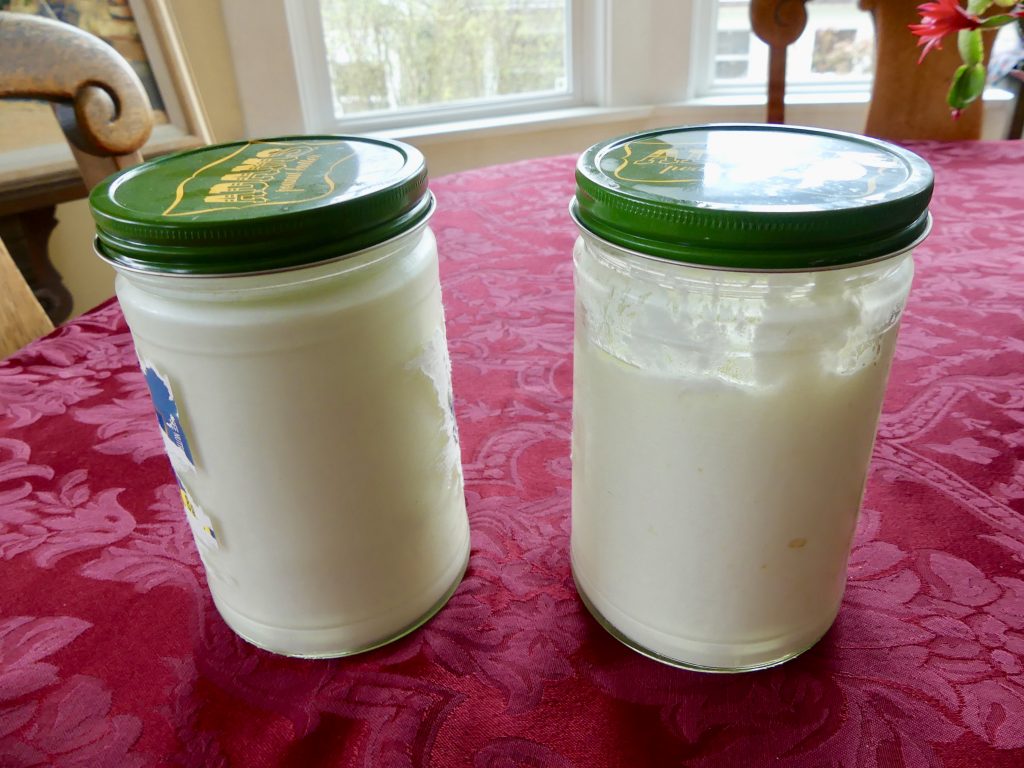
Homemade Yoghurt
(To do a gallon, just quadruple this recipe.)
1 qt. milk (any type)
1/4 c. dry milk powder for a thicker product more like Greek yoghurt (opt.- I don’t use this)
And/Or 1 T. thickener; such as carrageenan, pectic, or gelatin (opt.)
2 T. plain yogurt with live cultures. You don’t need special yoghurt starters but if you are nervous about experimenting like this you might like to try with a yoghurt starter the first time.
1. Combine the milk, milk powder (if using), and thickener (if using). Heat the mixture to 180F.
2. Let the milk cool to 120F. Add the yoghurt; mix well.
3. Keep covered, at 120F, for at least 6 hours, or until set to the consistency of thick cream. (For this step I pour it into old glass peanut butter jars with metal lids and cover it with a warm blanket and place in a warm room. Alternatively put it in your oven preheated to 150F and turn it off. Wrap the yoghurt in a blanket or towels and set it in a pan all wrapped up. After three hours REMOVE THE JARS , reheat the oven, turn it OFF again and put the jars back.)
4. Refrigerate and serve cold. This will keep, refrigerated, for up to 2 weeks.
5. Remember to save some of the old yogurt for your next batch!
by Lilly Lewin
We are approaching the second Sunday of Easter. And Orthodox Easter Sunday is this weekend April 8th. So if you’ve felt like you’ve missed out on Easter or not really had a chance to celebrate or engage Easter and the Resurrection, you aren’t too late. Maybe you are just recovering from a long week of Holy Week services, or a lot of time with family, or a holiday that now means laundry and catch up at the office or home. Too often in contemporary church land, we have forgotten that Easter is a season not just one day. Eastertide, or the season of Easter is the period in time between now and the day of Pentecost when the gift of the Holy Spirit is given. That is May 20th this year. So we can start today and embrace Easter and take time to find and reflect on Resurrection and what that means to us.
Resurrection is a process, not just one day of celebration. In fact, there were a lot of other emotions that would better reflect on the Resurrection than celebration. Mary goes to the tomb expecting to find the body of her friend and savior and wondering how in the world they can move the stone away from the tomb so they can further embalm him. Peter and the other disciples are certain they will be next on the Roman hit list, or that of the Pharisees, so they are in hiding. Thomas has gone his own way, perhaps needing to be outside to process what he’s just experienced in witnessing the death of his friend. On that first Easter morning, no one expected the Resurrection. In their grief, they were all caught of guard.
How about you? How are you experiencing Resurrection and Easter this year?
The beautiful thing about Jesus is that He knows us and loves us in the midst of wherever we are on our journey and in whatever state we find ourselves emotionally and physically. I told students last week that Jesus isn’t afraid of our fears, or our doubts, or even our anger towards Him. He loves us so much more than we can imagine! Jesus wants relationship with us! He invites us to be real and honest with Him.
How are you feeling about Resurrection this year?
Are you feeling bold or more afraid? Are you hiding or going boldly to the tomb?
Maybe you too are wondering who will roll away the stone? What stone is blocking your way today? What is the stone that you need rolling away in order to see Jesus? In order to experience Resurrection? Find a stone to use as a symbol of the stone that needs moving. Talk to Jesus about this.
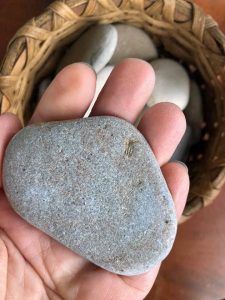 Are you hiding? or Feeling scared?
Are you hiding? or Feeling scared?
Are you missing the signs? Or just missing in action, not in the room where it happens? Talk to Jesus about this.
Are you feeling like Thomas, that you need to actually touch Jesus’s scars?
Take time to imagine this and talk to Jesus.
What things would help you recognize Jesus? What thing would help you have new eyes to see the resurrected Jesus? After seeing that the body was no longer in the tomb, Mary didn’t recognize Jesus. She wasn’t able to see Him until Jesus spoke her name. Maybe you need Jesus to speak your name so you can see Him and recognize Him today. Talk to Him about this. Give Jesus your old eyesight and ask for new eyes to see Him and new hands to touch Him.
Who is Jesus inviting you to tell or announce Resurrection? Who in your life needs to know that death is conquered? Maybe that person is you!
Our hope in Easter is that we no longer have to be afraid. We don’t have to hide anymore! Jesus is truly RISEN, and DEATH IS CONQUERED! We are now invited into a new adventure of Kingdom Living! A new way to live! An Adventure of living in Hope, Joy, Peace and Love! How does that feel? What adventure would you like to go on with Jesus in this new Easter Season? Where would you like to be in your relationship and in your life with Jesus by Pentecost? Take some time today to consider this. Journal about this. Sit with the questions.
Here are a few resources to help you engage Easter this year.
Vanderbilt Divinity School has put together slide shows to go with the gospel lessons that include great art! even if you don’t use these in worship, they are great for personal reflection. Slide show
Rob Bell has a wonderful podcast on Easter called “She thought he was the Gardner”
And my good friend Kara Root who is a Presbyterian pastor in Minneapolis posted her thoughts on not really feeling Easter this year. Blogpost
And another friend of mine Fr. Dixon Kinser did a great sermon using Art as symbols of Resurrection. check out his youtube video
Why not find a symbol that helps you remember Resurrection and New Life in Jesus. Maybe it’s a branch with new buds, maybe it is some tulip bulbs you can watch grow and bloom, maybe it’s a photo or an art piece. You choose.
And have a wonderful time finding Easter!
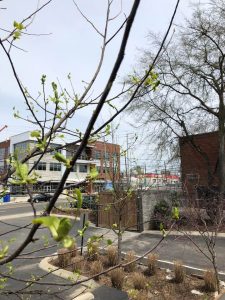
by Christine Sine.
We are in the process of creating a resource list on sustainability but there is one organization that stands out for me as a leader in this field because they provide practice resources for families and communities to reorder their lives around what really matters. They really seem to have caught hold of a new dream. They have resources on how to cut back waste, build community connections and reduce consumption. In the process they encourage people to have more fun and buy less stuff while bringing about change in their communities.
I highly recommend their resources including:
Community in Action Challenges
So Kind – an Alternative Gift Registry
As we work on this new resource list we would like to highlight other organizations that are working towards the sustainability of our ways of life. What organizations do you recommend? How do you feel we can live more sustainably in our world?
When we think about sustainability, Wendell Berry is one of the people who immediately springs to mind. His writing and environmental advocacy have had a huge impact on my life and on those of many others around the world. He has written more than 50 books and numerous poems, and as we begin our focus on sustainability, this wonderful poem immediately comes to mind. I particularly love the words So, friends, every day do something that won’t compute. Love the Lord. Love the world. Work for nothing. It ends appropriately with the words “practice resurrection“. I hope you will take time not just to read this poem but to reflect on the powerful message it conveys.
Love the quick profit, the annual raise,
vacation with pay. Want more
of everything ready-made. Be afraid
to know your neighbors and to die.
And you will have a window in your head.
Not even your future will be a mystery
any more. Your mind will be punched in a card
and shut away in a little drawer.
When they want you to buy something
they will call you. When they want you
to die for profit they will let you know.
So, friends, every day do something
that won’t compute. Love the Lord.
Love the world. Work for nothing.
Take all that you have and be poor.
Love someone who does not deserve it.
Denounce the government and embrace
the flag. Hope to live in that free
republic for which it stands.
Give your approval to all you cannot
understand. Praise ignorance, for what man
has not encountered he has not destroyed.
Ask the questions that have no answers.
Invest in the millennium. Plant sequoias.
Say that your main crop is the forest
that you did not plant,
that you will not live to harvest.
Say that the leaves are harvested
when they have rotted into the mold.
Call that profit. Prophesy such returns.
Put your faith in the two inches of humus
that will build under the trees
every thousand years.
Listen to carrion – put your ear
close, and hear the faint chattering
of the songs that are to come.
Expect the end of the world. Laugh.
Laughter is immeasurable. Be joyful
though you have considered all the facts.
So long as women do not go cheap
for power, please women more than men.
Ask yourself: Will this satisfy
a woman satisfied to bear a child?
Will this disturb the sleep
of a woman near to giving birth?
Go with your love to the fields.
Lie down in the shade. Rest your head
in her lap. Swear allegiance
to what is nighest your thoughts.
As soon as the generals and the politicos
can predict the motions of your mind,
lose it. Leave it as a sign
to mark the false trail, the way
you didn’t go. Be like the fox
who makes more tracks than necessary,
some in the wrong direction.
Practice resurrection.
Manifesto: The Mad Farmer Liberation Front” from The Country of Marriage, copyright © 1973 by Wendell Berry
by Mary Harwell Sayler —
The Kingdom of God is at hand
and foot, and I
am
an animated muscle of animal,
the mineral of blood and bone,
a vegetation of sleep until
You arouse me,
breathing on.
by Christine Sine
Yesterday was Easter Sunday – the central celebration of our faith and the culmination of our walk through Lent. But where fo we go from here? How do we sustain the practices that the season of Lent planted in our lives?
Surprisingly when I posed this question to a friend yesterday he responded: No one has ever asked me that before. It is as though Lent is an end in itself and once Easter is over it is back to life as usual. Yet the celebration of Easter is not for a day – it is 50 days long, longer than Lent, longer than advent and longer than Christmas. That should tell us something about how important it is for our faith. Through Christ’s resurrection, God’s new world has broken into ours. There is much to rejoice in and even more to participate in.
Living Into A Sustainable World
On Godspace our theme for the season is Living Into a Sustainable World. In a world of climate change, environmental degradation, gun violence, injustice and persecution, how do we live into and sustain the glimpses of God’s new world that are breaking into ours? There are four types of sustainability we talk about – human, economic, social and environmental. My hope is that this season will give us much to reflect on in all these areas, and bring awe inspiring glimpses of God world of justice, equality and abundance – from practical ways to reduce waste, shop more responsibly and help preserve God’s creation, to suggestions on how to become more engaged as instruments of generosity, mercy and love. Keep an eye open for the new resource lists we plan to post too.
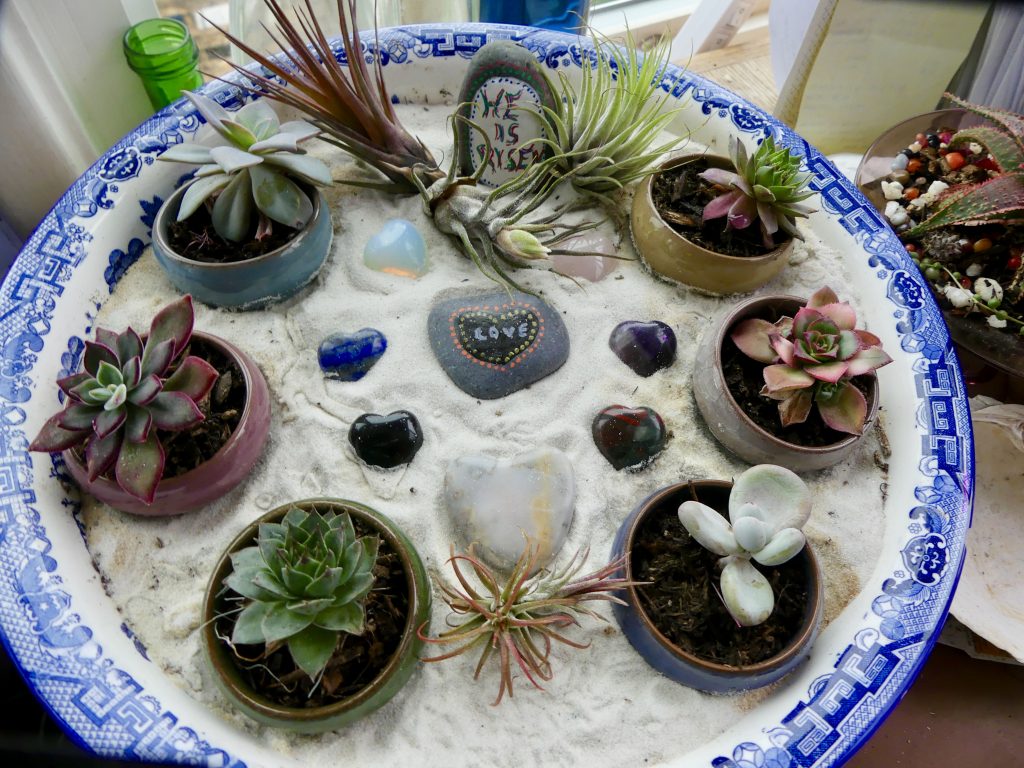
Easter resurrection garden
My own celebration for this season began with the creation of a new contemplative garden. This time I didn’t dismantle my old garden, I transformed it, allowing myself to enter fully into the power of transformation that Easter represents.
As I looked at my garden this morning, I realized that over the season of Lent transformation has already occurred. I have had a grow light shining on it and as result several of the plants which once looked green are now tinged with red and yellow. The light has transformed them and their true colours have emerged. But to keep those colours the light needs to shine.

Let the Light Keep Shining
That’s it, I thought. To grow the practices I planted during Lent I need to keep shining the light of Christ on them. There are three practices I planted that this applies to – one in my personal life (to be more focused in my contemplative practices) one in my relational life (to respond with kindness rather than irritability) and one in my concern for the environment (to reduce my waste that goes into the landfill by 20%). I have written these in my Easter journal and will let you know how I grow these practices over the next few weeks.
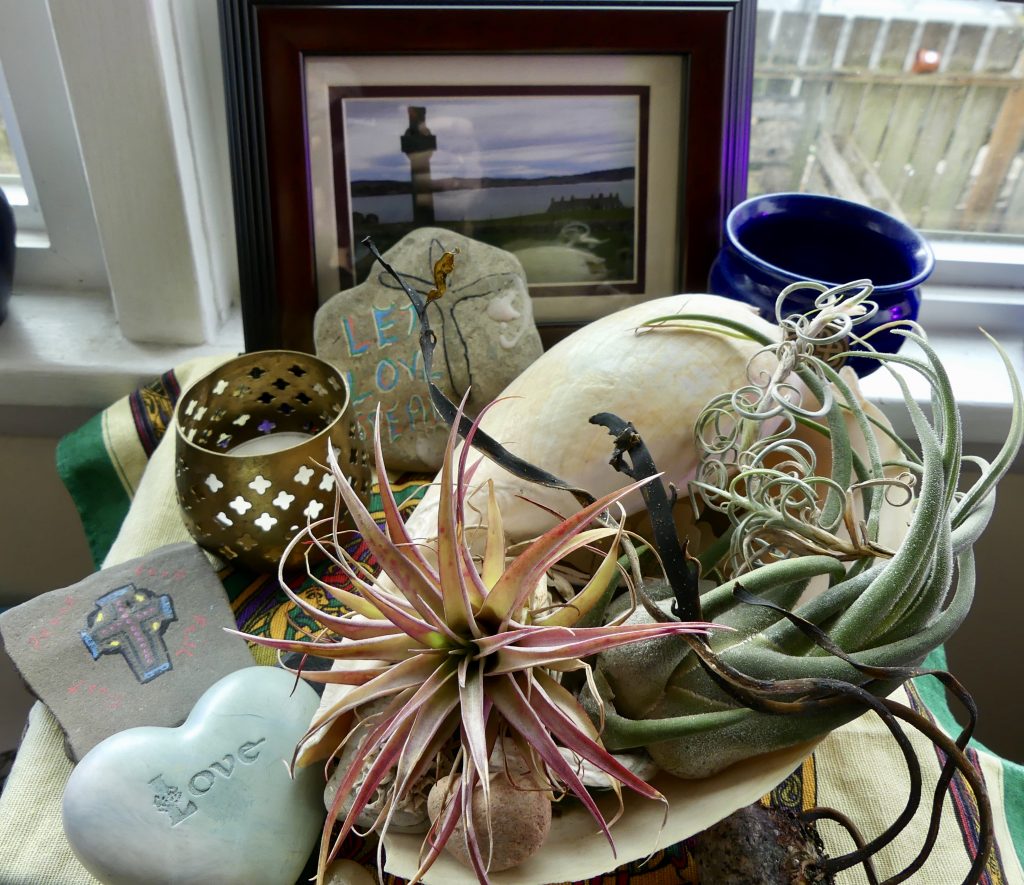
easter Altar
Establish a New Altar.
The place I realized this morning that I needed to start was with redesigning my prayer altar for the season too. I took off my Lenten table cloth and replaced it with my favourite Celtic cloth. I added a new photo, one that is more celebrative than the rather somber artwork I used during Lent and pulled out some of my favourite painted rocks. I chose to do this rather than creating new ones because I wanted to emphasize my need to recycle and reuse rather than adding something more to my collection. I also set up a collage that my friend Joyce Winthrow gave me several years ago. Its joyful colours give my whole contemplative corner a wonderful Easter feel. It’s getting a little crowded but I also added a small chalice that I picked up at Goodwill a couple of weeks ago. It will serve as a gratitude jar for the season, a place for me to collect reminders of all that I have to thank God for.
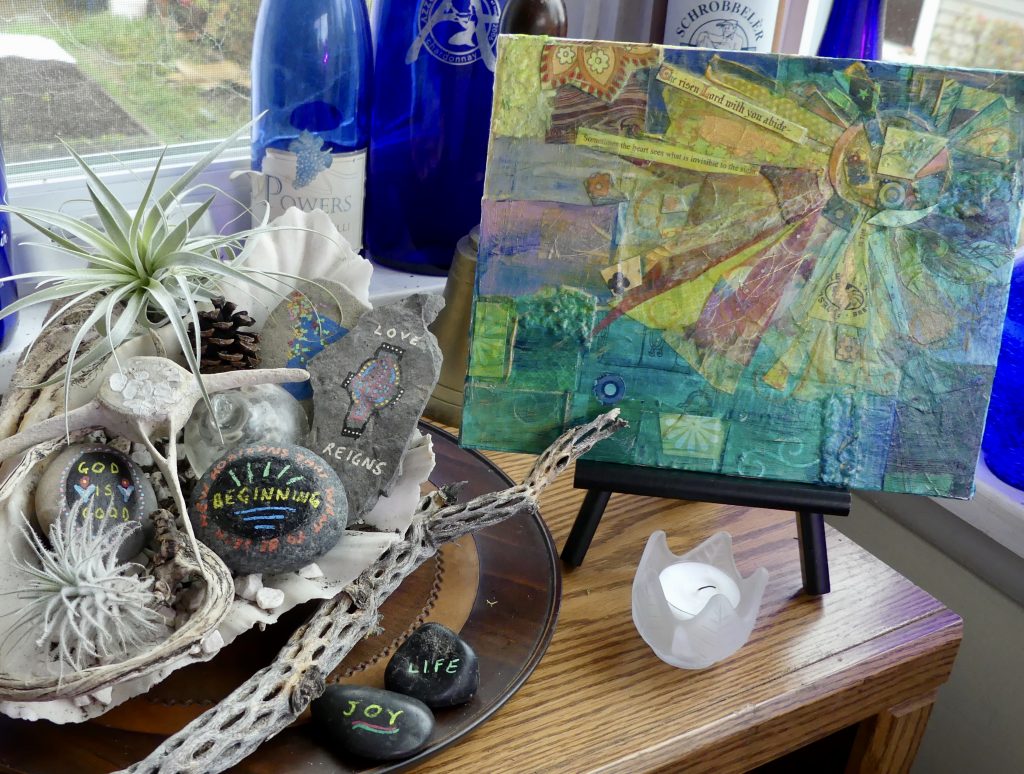
Collage by Joyce Withrow
Work Towards New Practices
Resurrection is about a new way of living – a transformed way of life that has the ways of God’s kingdom at the centre. So I know I need to establish some new practices, practices that help me sustain the life that God has renewed within me. For me that means evaluating my morning and evening routines, a practices I highly recommend to you
- Prayerfully consider – what would your ideal morning and evening routines look like? To do this we need to make sure we are asking the right questions. It wasn’t the empty tomb that impressed people as they listened to the reports of Jesus’ resurrection, it was the transformation they saw in his disciples’ lives. How has Jesus resurrection transformed your life? your relationships? and your responsibility to this wonderful world God has gifted us with?
- Routines need to cover all aspects of our lives. Think about how to incorporate contemplative and reflective times as well as physical and creative activities that stir your senses and draw you into God’s presence. Morning and evening might be too much for you to consider. Be realistic. Work out what time of the day you would most like to use for your intimate time with God and for other exercises that draw you close to your Creator. Then think about the ways you should be reaching out. This is probably not part of your morning or evening routine, but what you do in the morning and the evenings is the soil and the fertilizer that makes it possible for you to go out into God’s world as a servant disciple.
- Evaluate your present routines – once you know what the strengths and weaknesses of your present practices are it will make it easier to change where necessary.
- Decide on a plan – write down what you think your routines could look like and take the next month to experiment. You might find that a journal or planner will help this process and in fact assist you to map out your whole routine.
- Set some goals for the coming month. Don’t try to bite off more than you can chew. Sustained growth is slow and incremental not all at once.
- Implement your plan. Jesus’ disciples plunged into a new way of life even though they were afraid and unsure of the consequences and we need to too. This is not a time for making excuses. Following Jesus requires commitment and discipline. Now is a good time to start.
What Is Your Response
Prayerfully consider how God would have you respond in this easter season. What seeds have been planted in your life that need to be nurtured, grow and bear fruit? May God guide you in your journey.
As an Amazon Associate, I receive a small amount for purchases made through appropriate links.
Thank you for supporting Godspace in this way.
When referencing or quoting Godspace Light, please be sure to include the Author (Christine Sine unless otherwise noted), the Title of the article or resource, the Source link where appropriate, and ©Godspacelight.com. Thank you!


